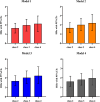Association between blood pressure multi-trajectory and cardiovascular disease among a Chinese elderly medical examination population
- PMID: 39114559
- PMCID: PMC11303174
- DOI: 10.3389/fcvm.2024.1363266
Association between blood pressure multi-trajectory and cardiovascular disease among a Chinese elderly medical examination population
Abstract
Objective: This study aimed to characterize multivariate trajectories of blood pressure [systolic blood pressure (SBP) and diastolic blood pressure (DBP)] jointly and examine their impact on incident cardiovascular disease (CVD) among a Chinese elderly medical examination population.
Methods: A total of 13,504 individuals without CVD during 2018-2020 were included from the Chinese geriatric physical examination cohort study. The group-based trajectory model was used to construct multi-trajectories of systolic blood pressure and diastolic blood pressure. The primary outcome was the incidence of the first CVD events, consisting of stroke and coronary heart diseases, in 2021. The Cox proportional hazards model was used to calculate the hazard ratios (HRs) and 95% confidence intervals (CIs) for the association between BP multi-trajectories and incident CVD events.
Results: We identified four blood pressure (BP) subclasses, summarized by their SBP and DBP levels from low to high as class 1 (7.16%), class 2 (55.17%), class 3 (32.26%), and class 4 (5.41%). In 2021, we documented 890 incident CVD events. Compared with participants in class 1, adjusted HRs were 1.56 (95% CI: 1.12-2.19) for class 2, 1.75 (95% CI: 1.24-2.47) for class 3, and 1.88 (95% CI: 1.24-2.85) for class 4 after adjustment for demographics, health behaviors, and metabolic index. Individuals aged 65 years and above with higher levels of BP trajectories had higher risks of CVD events in China.
Conclusions: Individuals with higher levels of both SBP and DBP trajectories over time were associated with an increased risk of incident CVD in the Chinese elderly population.
Keywords: blood pressure; cardiovascular disease; elderly population; group-based trajectory model; multivariate trajectory.
© 2024 Chen, Du and Hong.
Conflict of interest statement
The authors declare that the research was conducted in the absence of any commercial or financial relationships that could be construed as a potential conflict of interest.
Figures




Similar articles
-
Association between cumulative blood pressure and long-term risk of cardiovascular disease: findings from the 26-year Chinese Multi-provincial Cohort Study-Beijing Project.Chin Med J (Engl). 2021 Mar 1;134(8):920-926. doi: 10.1097/CM9.0000000000001383. Chin Med J (Engl). 2021. PMID: 33655897 Free PMC article.
-
Association of Blood Pressure Trajectory With Mortality, Incident Cardiovascular Disease, and Heart Failure in the Cardiovascular Health Study.Am J Hypertens. 2017 Jun 1;30(6):587-593. doi: 10.1093/ajh/hpx028. Am J Hypertens. 2017. PMID: 28338937 Free PMC article.
-
Associations between long-term blood pressure trajectory and all-cause and CVD mortality among old people in China.Front Cardiovasc Med. 2023 Aug 17;10:1157327. doi: 10.3389/fcvm.2023.1157327. eCollection 2023. Front Cardiovasc Med. 2023. PMID: 37663420 Free PMC article.
-
[Association between long-term blood pressure change and the incidence of cardiovascular diseases: a population-based cohort study].Zhonghua Xin Xue Guan Bing Za Zhi. 2018 Sep 24;46(9):695-700. doi: 10.3760/cma.j.issn.0253-3758.2018.09.005. Zhonghua Xin Xue Guan Bing Za Zhi. 2018. PMID: 30293375 Chinese.
-
Prognostic interactions between cardiovascular risk factors.Dan Med J. 2014 Jul;61(7):B4892. Dan Med J. 2014. PMID: 25123126 Review.
References
LinkOut - more resources
Full Text Sources

